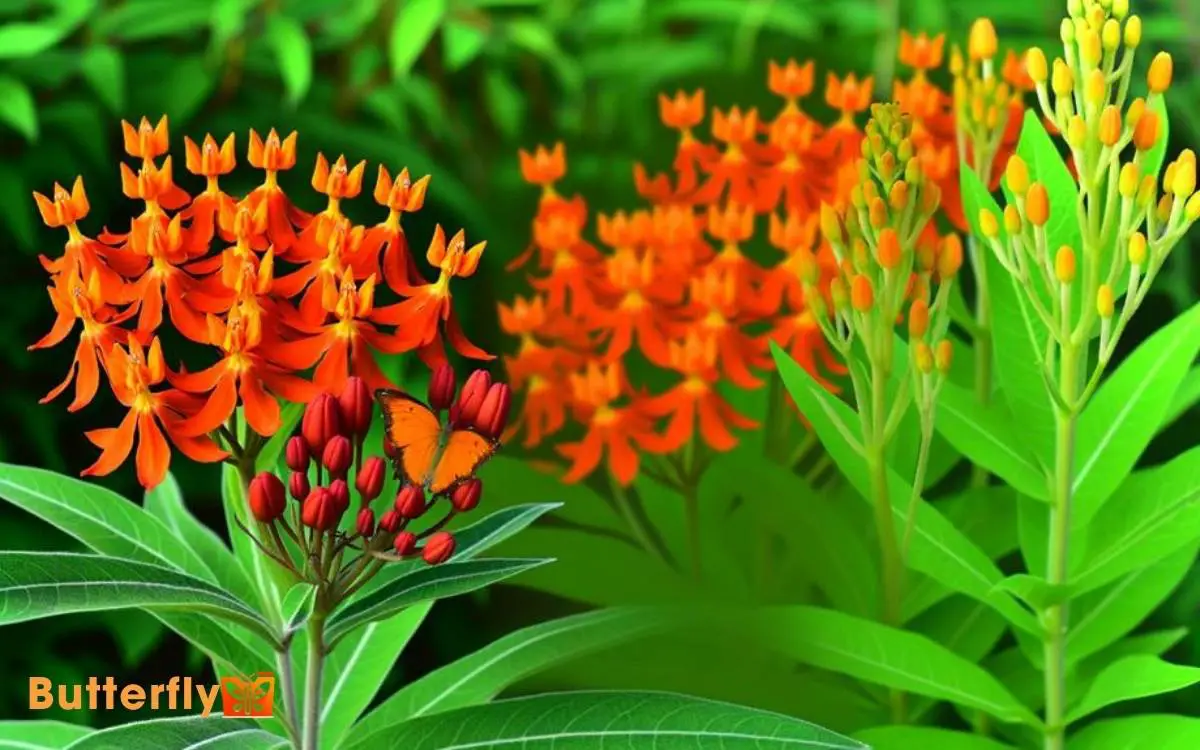How Big Does Butterfly Weed Get? 1 to 3 Feet!
To thrive, provide full sun exposure and well-drained soil, ideally in USDA hardiness zones 3 through 9. Maintain consistent moisture but avoid waterlogging. Sandy or loamy soil with a pH of 6.0 to 7.5 is preferred.
Expect a moderate growth rate, with plants maturing in 2-3 years. Proper spacing, about 18 to 24 inches, is essential for healthy growth. For more insights on growing conditions and companion plants, check further details.

Key Takeaways
Typical Height of Butterfly Weed
Typically, butterfly weed (Asclepias tuberosa) reaches a height of 1 to 3 feet. You’ll find that it usually grows to about 2 feet under ideal conditions.
When planting butterfly weed, make sure the soil is well-drained and located in full sun for maximum growth.
This perennial prefers sandy or gravelly substrates, which support its root system effectively. You should monitor soil pH levels, ideally maintaining a range between 6.0 and 7.0.
Regular watering during the establishment phase promotes robust vertical growth. However, once established, butterfly weed is drought-tolerant.
Spread and Width
Butterfly weed (Asclepias tuberosa) generally spreads to a width of 1 to 2 feet, creating a compact and manageable footprint in your garden.
This perennial’s spread guarantees it won’t overwhelm other plants, making it ideal for small garden spaces. Make sure you space your butterfly weed plants correctly to avoid overcrowding.
| Characteristic | Details |
|---|---|
| Spread Width | 1 to 2 feet |
| Ideal Spacing | 18 to 24 inches |
| Soil Preference | Well-drained |
| Sunlight Requirement | Full sun |
| Water Needs | Low to moderate |
Planting in well-drained soil and providing full sunlight optimizes its growth. Butterfly weed’s minimal water needs make it a low-maintenance addition. Proper spacing, around 18 to 24 inches apart, ensures each plant thrives without competition.
Growth Rate
Expect butterfly weed to exhibit a moderate growth rate, often reaching its mature size within two to three years. You’ll notice its initial growth is relatively slow, as the plant focuses on establishing a robust root system.
Typically, butterfly weed grows about 12 to 36 inches in height annually. To achieve best growth, guarantee consistent moisture during the first growing season. Once established, Asclepias tuberosa becomes drought-tolerant, reducing the need for frequent watering. Additionally, this vibrant perennial thrives in full sun and well-drained soil, attracting pollinators such as bees and butterflies. The presence of butterfly weed in a garden can offer a valuable nectar source, potentially influencing butterfly flight speed as they move between blooms. Its long-lasting orange flowers make it a favorite among gardeners looking to support local wildlife while adding a splash of color to their landscapes.
Prune dead stems in early spring to encourage vigorous growth. Remember, patience is key; butterfly weed’s growth rate is steady but deliberate. By the third year, you’ll appreciate its full, vibrant display, attracting butterflies and other pollinators to your garden.
Ideal Growing Conditions
To thrive, Asclepias tuberosa requires full sun exposure and well-drained soil with a pH between 6.0 and 7.0. Position your plants where they receive at least 6 hours of direct sunlight daily.
This perennial prefers a temperate climate, with best growth occurring in USDA hardiness zones 3 through 9. Guarantee your planting site is free from excessive shade, as insufficient sunlight can reduce flowering and weaken the plant.
Temperature is vital; maintain ambient temperatures between 70°F and 85°F during the growing season for best development. Additionally, provide good air circulation to prevent fungal diseases.
Soil and Water Requirements
To ensure optimal growth, ensure that the soil is well-drained and moderately fertile, with consistent moisture levels maintained through regular watering.
Butterfly weed thrives in sandy or loamy soil with a pH range of 6.0 to 7.5. It is crucial to avoid waterlogged conditions, as they can lead to root rot.
Here’s a quick reference:
| Factor | Requirement |
|---|---|
| Soil Drainage | Well-drained |
| Soil Type | Sandy/Loamy |
| Soil pH | 6.0 – 7.5 |
| Watering Frequency | Regular, moderate |
| Watering Amount | 1 inch per week |
Monitor the soil moisture by inserting your finger about an inch deep; if it feels dry, it’s time to water. Avoid overhead watering to reduce the risk of fungal diseases.
Pruning and Maintenance
When maintaining butterfly weed, you should prune in late winter to early spring, using sterilized pruning shears for precise cuts.
- Trim back to 15-30 centimeters above ground level to encourage robust growth.
- Regularly inspect for dead stems and remove them to promote excellent plant health.
Optimal Pruning Time
Prune butterfly weed in early spring to promote vigorous growth and ideal blooming. Timing is vital; late March to early April is best when new growth begins.
Follow these steps for effective pruning:
- Remove Dead Stems: Cut back any dead or damaged stems to the base.
- Trim Last Year’s Growth: Trim last year’s growth to about 6 inches, encouraging new, healthy shoots.
- Shape the Plant: Shape the plant by cutting back uneven or excessively tall stems to maintain a uniform appearance.
- Clean Up Debris: Clear away fallen leaves and debris to prevent disease and pests.
Necessary Tools Needed
To achieve the best results in pruning and maintaining butterfly weed, you’ll need specific tools designed for precision and efficiency.
First, invest in high-quality bypass pruners with sharp blades, ideally made from carbon steel, ensuring clean cuts without damaging plant tissue. Choose a blade length of 6-8 inches for top control.
For thicker stems, utilize loppers with a cutting capacity of up to 2 inches in diameter. Additionally, a pair of fine-tipped pruning scissors will help you remove spent flowers and smaller stems with precision.
A sturdy pair of gardening gloves will protect your hands from sap and thorns. Finally, a small hand rake is essential for removing debris around the base, promoting healthy growth.
Seasonal Maintenance Tips
Regular pruning and maintenance of butterfly weed promote vigorous growth and vibrant blooms throughout the growing season.
To keep your butterfly weed healthy and attractive, follow these expert tips:
- Early Spring Pruning: Cut back last year’s growth to 2-3 inches above the ground before new shoots appear. This encourages robust, fresh growth.
- Deadheading: Remove spent flowers regularly to extend the blooming period. Snip just above a leaf node using sterilized pruning shears.
- Mid-Season Trim: If the plant becomes leggy, trim back by one-third to stimulate bushier growth.
- Fall Cleanup: After the first frost, cut back stems to ground level to prevent disease and pest overwintering.
Seasonal Growth Patterns
You’ll observe a significant growth surge in butterfly weed during the spring, with plants reaching up to 24 inches in height.
By fall, the plant enters a dormancy phase, halting growth and preparing for winter. Understanding these patterns helps in optimizing care routines for robust development.
Spring Growth Surge
During the spring growth surge, butterfly weed (Asclepias tuberosa) can rapidly attain heights of up to 2-3 feet, exhibiting a robust increase in both stem and leaf development.
To guarantee ideal growth during this period, consider the following:
- Soil Quality: Guarantee well-draining soil with a pH of 6.0-7.0.
- Sunlight Exposure: Provide full sun, a minimum of 6-8 hours daily.
- Watering Schedule: Water moderately, allowing the soil to dry between waterings.
- Nutrient Supply: Apply a balanced fertilizer (10-10-10) bi-monthly.
Fall Dormancy Phase
As autumn progresses, butterfly weed (Asclepias tuberosa) enters a fall dormancy phase, characterized by a cessation of growth and a gradual dieback of stems and foliage. You’ll notice the plant’s above-ground parts turning brown and brittle.
This period is crucial for the perennial’s lifecycle, allowing it to conserve energy for the next growing season. Don’t worry about the dieback; it’s a normal part of the plant’s growth patterns.
To prepare for winter, cut back the stems to about 2-3 inches above ground level, which helps reduce pest and disease problems. Mulching with a 2-inch layer can protect the root system from extreme cold.
Factors Affecting Size
Butterfly weed’s size is influenced by factors such as soil quality, sunlight exposure, and water availability.
To optimize its growth, you should consider:
- Soil Quality: Guarantee well-draining soil with a pH range of 6.0 to 7.0. Nutrient-rich, loamy soils promote robust growth.
- Sunlight Exposure: Provide full sun for at least 6 hours daily. Insufficient light can stunt growth.
- Water Availability: Maintain consistent moisture without waterlogging. Drought conditions can limit plant height and spread.
- Spacing: Plant butterfly weed with a spacing of 18 to 24 inches apart. Overcrowding can restrict root development and reduce overall size.
Companion Plants
Choosing the right companion plants for butterfly weed can enhance its growth and attract more pollinators to your garden. Opt for plants that thrive in similar conditions, such as full sun and well-drained soil.
Good choices include purple coneflower (Echinacea purpurea) and black-eyed Susan (Rudbeckia hirta), which also bloom during summer months. These plants create a vibrant display and provide continuous nectar sources.
Additionally, consider grasses like little bluestem (Schizachyrium scoparium) for structural contrast and habitat diversity. Avoid highly aggressive species that could overshadow your butterfly weed, limiting its access to light and nutrients.
By carefully selecting companions, you’ll foster a thriving, balanced ecosystem that supports both plant health and pollinator activity.
Conclusion
To sum up, butterfly weed typically reaches a height of 1.5 to 3 feet and spreads 1 to 1.5 feet wide. For peak growth, guarantee well-drained soil, moderate watering, and full sun exposure.
Prune in late winter to promote healthy growth. Understanding these factors height, spread, and ideal conditions will help you cultivate vibrant butterfly weed. Pair it with nectar-rich companion plants for a thriving garden ecosystem.
Master these techniques, and you’ll enjoy a stunning, butterfly-friendly landscape.






